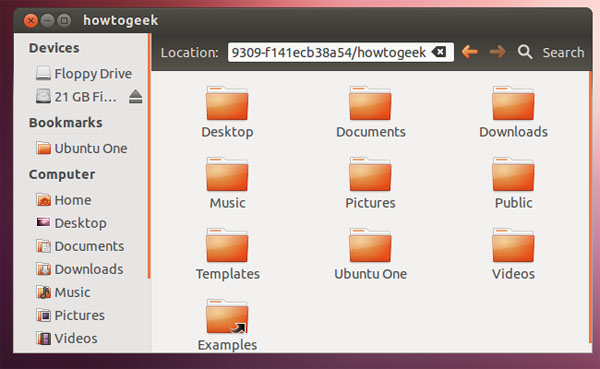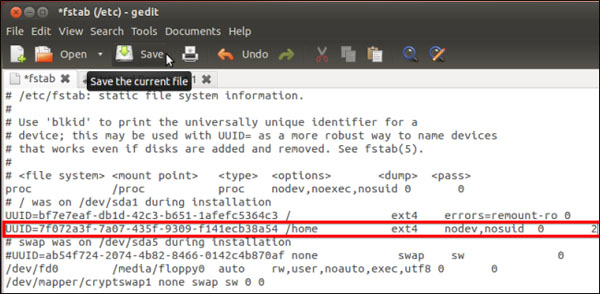Instructions for creating a master partition in Ubuntu
TipsMake.com - Ubuntu does not use a separate master partition by default, although many Linux users prefer this. Use a separate master partition to allow you to reinstall Ubuntu without losing personal files and settings.
While a master partition is usually selected during installation, you can also move the master partition after installing Ubuntu.
During Ubuntu installation
Creating a home folder (Home Folder) while installing Ubuntu is easy. Choose the option to install 'Something Else' to customize the partition and create multiple partitions. Set the mount point for each partition to '/' to contain the root file system and mount point of another partition as / home. When installing Ubuntu in the future, users can set the old master partition to / home again, but make sure not to tick the Format box or the entire file will be deleted.

After installing Ubuntu
If you did not create a master partition during Ubuntu installation, you do not have to reinstall Ubuntu from the beginning. To move the master partition after installation, we will have to create a new partition, copy the file from the current home directory to this partition and tell Ubuntu to extract the new partition at / home.
Step 1: Create a new partition
If there is an empty storage space, this step is easy. If not, we will have to resize the system partition and create a new partition at the empty storage space. If there is an empty storage space or you do not need to resize the system partition, you only need to install GParted and create a partition without rebooting from the CD. Here we create a partition named ext4.

Step 2: Copy the file in the Home Folder to the new partition
Ubuntu extracts the file to a new partition very easily, just click below the Devices section in the file manager. After that, click on the Go menu and select Location to view the mount point.

Launch the command window and execute the following command to create a copy of the current home directory on the new partition, with / mount / location as the location of the extracted partition:
sudo cp –Rp / home / * / mount / location
We will see an error about a .gvfs folder but it's okay, ignore it.

Users should check the new home directory to confirm that it contains your files. However, we have not deleted the old home directory yet.

Step 3: Locate the UUID for the new partition
The long string of characters is actually the new UUID of the partition and we will need it to add the partition to the fstab file to tell Linux the location of the partitions when it starts. Users can also locate the UUID by entering the following command in the command window:
sudo blkid

Step 4: Edit the fstab file
Before fixing the fstab file, we should create a backup to restore it if something goes wrong:
sudo cp / etc / fstab /fstab.backup
Next, enter the following command to open the fstab file in gedit. You can also use another text editor if you want.
gksu gedit / etc / fstab
Add the following text to the fstab file on a new line, replacing '_____' with the new master UUID from the sudo blkid statement on:
UUID = _____ / home ext4 nodev, nosuid 0 2

Save the file after adding the line.
Step 5: Move the home directory location and reboot
From the command prompt, enter the following command to move the current home directory to a reserved location and create another new, empty home directory for the new partition to populate:
cd / && sudo mv / home / home_old && sudo mkdir / home

Restart the computer after running this command. Can restart with the command:
sudo shutdown -r now
After restarting the computer, you can log in normally. Ubuntu now uses separate master partitions. After making sure everything is fine and you still have all the files in the / home directory, you can remove the / home_old folder to free up memory:
sudo rm -rf / home_old
You should read it
- What is the Master Partition Table?
- How to remove the drive partition on macOS
- Beautiful wooden living room partitions help the house more spacious and luxurious
- Restore deleted drive partitions with Active Partition Recovery
- How to access Windows encrypted partitions using Bitlocker from Linux
- 10 free partitioning tools
- 2 ways to hide hard disk partitions on Windows
- How to encrypt partitions on Linux with dm-crypt
May be interested
- What's New in Ubuntu 21.10?
 version 21.10 is the latest release of ubuntu and although canonical is turning more attention to the cloud and developers, ubuntu 'impish indri' still comes with some notable changes for those users use the ubuntu desktop every day.
version 21.10 is the latest release of ubuntu and although canonical is turning more attention to the cloud and developers, ubuntu 'impish indri' still comes with some notable changes for those users use the ubuntu desktop every day. - How to split the hard drive, merge the partition on Windows XP without worrying about losing data
 the need to increase or decrease the amount of disk space in a computer is not small, such as increasing the capacity of the c drive for more data space for installing software, or merging small drives into a large drive. . for windows 7 or windows 10, the way to divide the hard drive is much easier. so what about managing hard drive partitions with win xp?
the need to increase or decrease the amount of disk space in a computer is not small, such as increasing the capacity of the c drive for more data space for installing software, or merging small drives into a large drive. . for windows 7 or windows 10, the way to divide the hard drive is much easier. so what about managing hard drive partitions with win xp? - Convert MBR to GPT on Windows drive
 the master boot record (mbr) drive uses a standard bios partition table. the guid partition table (gpt) drive uses the unified extensible firmware interface (uefi).
the master boot record (mbr) drive uses a standard bios partition table. the guid partition table (gpt) drive uses the unified extensible firmware interface (uefi). - Instructions for downloading Ubuntu - Download the latest Ubuntu
 instructions for downloading ubuntu - download the latest ubuntu. ubuntu is free and open source software, which means that users can freely run, copy, distribute, research, change and improve the software. that's one reason why software developers or developers often use this ubuntu operating system.
instructions for downloading ubuntu - download the latest ubuntu. ubuntu is free and open source software, which means that users can freely run, copy, distribute, research, change and improve the software. that's one reason why software developers or developers often use this ubuntu operating system. - How to create a Recovery partition to customize Windows recovery
 this article will guide you to restore windows to its original state with pre-installation by creating a custom recovery partition.
this article will guide you to restore windows to its original state with pre-installation by creating a custom recovery partition. - Instructions for Partitioning Hard Drives with Partition Wizard 100% Successful
 hoang ha pc will guide you how to successfully partition your hard drive using partition wizard. let's learn how to use partition wizard in the article below!
hoang ha pc will guide you how to successfully partition your hard drive using partition wizard. let's learn how to use partition wizard in the article below! - Ways to install Ubuntu on Windows, run in parallel or run separately
 there are many ways to install ubuntu on your computer, such as installing ubuntu from usb, cd, installing ubuntu running in parallel with windows, installing it
there are many ways to install ubuntu on your computer, such as installing ubuntu from usb, cd, installing ubuntu running in parallel with windows, installing it - How to Format a Hard Drive Using Ubuntu
 you can format your drives using the disks utility that comes installed with ubuntu. if the disks utility is giving you errors, or you have a corrupted partition, you can use gparted to format instead. you can also use gparted to resize...
you can format your drives using the disks utility that comes installed with ubuntu. if the disks utility is giving you errors, or you have a corrupted partition, you can use gparted to format instead. you can also use gparted to resize... - How to Format USB on Ubuntu
 with ubuntu linux, you can use several utilities to format usb, such as the disk utility feature that comes with ubuntu or terminal. regardless of which feature you use, formatting the usb will only take you a few minutes.
with ubuntu linux, you can use several utilities to format usb, such as the disk utility feature that comes with ubuntu or terminal. regardless of which feature you use, formatting the usb will only take you a few minutes. - Paragon Partition Manager - Download the latest Paragon Partition Manager
 paragon partition manager makes it easy to create, resize, reformat, and delete hard drive partitions.
paragon partition manager makes it easy to create, resize, reformat, and delete hard drive partitions.










 How to install software and applications for Linux operating systems
How to install software and applications for Linux operating systems Instructions for installing Ubuntu on VMware Workstation - Part 1
Instructions for installing Ubuntu on VMware Workstation - Part 1 Instructions for installing Ubuntu on VMware Workstation - Part 2
Instructions for installing Ubuntu on VMware Workstation - Part 2 How to install RPM files
How to install RPM files Instructions for installing LAMP on Ubuntu for beginners
Instructions for installing LAMP on Ubuntu for beginners Set up Ubuntu centralized management network with LDAP
Set up Ubuntu centralized management network with LDAP